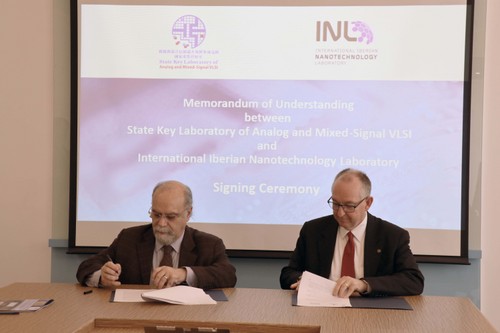 AMSV and INL from Portugal sign MOU on research collaboration
AMSV and INL from Portugal sign MOU on research collaboration
The University of Macau (UM) State Key Laboratory of Analog and Mixed-Signal (AMSV), recently signed a Memorandum of Understanding (MOU) with International Iberian Nanotechnology Laboratory (INL) from Braga, Portugal. This collaboration will enable both UM and INL to introduce a new level of signal processing for sensors, within the Internet of Things, and biomedical devices.
The MOU was signed by Prof Rui Martins, vice rector (research) of UM; and Prof Lars Montelius, director general of INL, in the witness of researchers and scholars from both UM and INL. According to Prof Montelius, this collaboration will strengthen INL’s capacity since the AMSV’s knowledge and research capacity are complimentary to INL. These initiatives aim to open new doors to scientific collaboration and new business opportunities to both AMSV and INL.
Many of the research activities of INL and AMSV are complementary: INL works on nanotechnology (back-end), while AMSV focuses on applications (front-end). This front-to-back-end collaboration increases the capability of both institutions to conduct cutting-edge research projects. The two institutions are currently working together on a research project titled ‘Portable Electronic Devices for Food-quality Screening’. This is their first joint research project. Located in Braga (north of Portugal), INL, one of the top laboratories of nanotechnology in Europe, was founded by the governments of Portugal and Spain under an international legal framework to perform interdisciplinary research, as well as deploy and articulate nanotechnology for the benefit of society.


